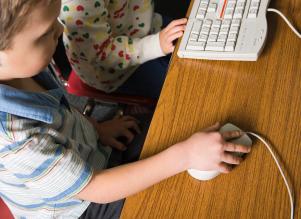3/20/2017
Technology Integration Guidance for Early Childhood Education
For today’s students, learning to use new technologies is a necessary life skill. As more of our business and personal lives take place online, it’s only natural that students must learn to use keyboards, touch screens, and other digital tools as part of their education.
However, it is equally important that devices used in the classroom support developmentally appropriate learning goals. While older students can use computers to research, write, and even share their work online, it’s more difficult to find appropriate ways for young children to use technology in the classroom. In fact, the National Association for the Education of Young Children (NAEYC) and the Fred Rogers Center for Early Learning and Children’s Media published a joint policy statement in 2012 to provide guidance on how to integrate new technologies into young children’s lives in developmentally appropriate ways.
Early childhood educators know that their young students are learning very different skills than those in later elementary school and beyond. Pre-K and kindergarten students are focusing on social-emotional skills, such as taking turns, sharing, and working with others. At the same time, these young students are practicing school-readiness skills, such as listening to teacher instruction and following multiple-step directions. They’re also developing the foundation for their academic knowledge by learning to identify letters, numbers, shapes, and colors. So, how can students this young interact with technology in a meaningful way?
With thoughtful guidance, classroom tech devices can be used to help early childhood students learn age-appropriate skills by supporting social-emotional development, encouraging following multi-step directions, and teaching core academic concepts.
Supporting social-emotional development
“Screen time” has a bad reputation for detracting from social interaction, which creates an inherent conflict for early childhood educators. Educators need to introduce students to new technologies, while at the same time ensure students are interacting with each other. Instead of fighting technology as a distraction, educators should embrace it as a tool. For example, young children typically find it easier to use a touchscreen than a mouse or keyboard, due to their still-developing fine motor skills. Using touchscreen devices, such as tablets and smart boards, allows students to physically interact with content. Children can also collaborate with each other, take turns, and share ideas as they complete activities, putting critical social-emotional skills to work.
Following multi-step directions
The ability to listen to, recall, and complete a series of directions is critical to completing many classroom activities. These are difficult skills for young students to master, so early childhood teachers spend a great deal of time working on them. Conventionally, students learn to follow directions through playing games such as Simon Says or completing craft activities, but digital tools offer an alternative approach that integrates fundamental early childhood skills and digital skills. Computers, tablets, and smart boards all require students to follow general directions. For example, students must learn to push a power button, swipe a window left or right, and select items on the screen. Students navigating their way through a simple computer game might need to follow the game’s commands, from pressing a button to start the game to swiping the screen to exit. A new focus on learning to code in early childhood focuses on how young children can learn sequencing, problem solving, and cause and effect through developmentally appropriate coding activities. Using digital tools often requires following multi-step directions, providing many opportunities to build this skill.
Teaching core academic skills
One of the most notable uses of digital technologies in the classroom is in teaching and reviewing core academic skills. A simple activity designed for a computer or tablet can help a student practice counting, associate sounds with letters, spell vocabulary words, and match shapes and colors. Digital activities can be developed to adapt to fit the needs of each student much more efficiently than a set of pre-printed worksheets. For example, a student who misses three questions in a row could automatically be redirected to more review material, while a student who quickly answers basic questions correctly could be switched to more advanced work. At a time when individualizing education is a priority for many educators, using digitally enhanced curricula in the classroom offers a solution for meeting the diverse learning needs of each student.
For students in early childhood classrooms, using digital tools can go hand in hand with developing social-emotional skills, school readiness, and core academics. Practicing these skills while also learning the basics of navigating digital devices will serve students well for years to come, as young students who feel comfortable and confident using new technologies will be eager to integrate more advanced digital tools into their work as they grow. Just as early childhood classrooms lay the foundation for academics, socialization, and school readiness, they can also provide a basis for using digital tools effectively.


